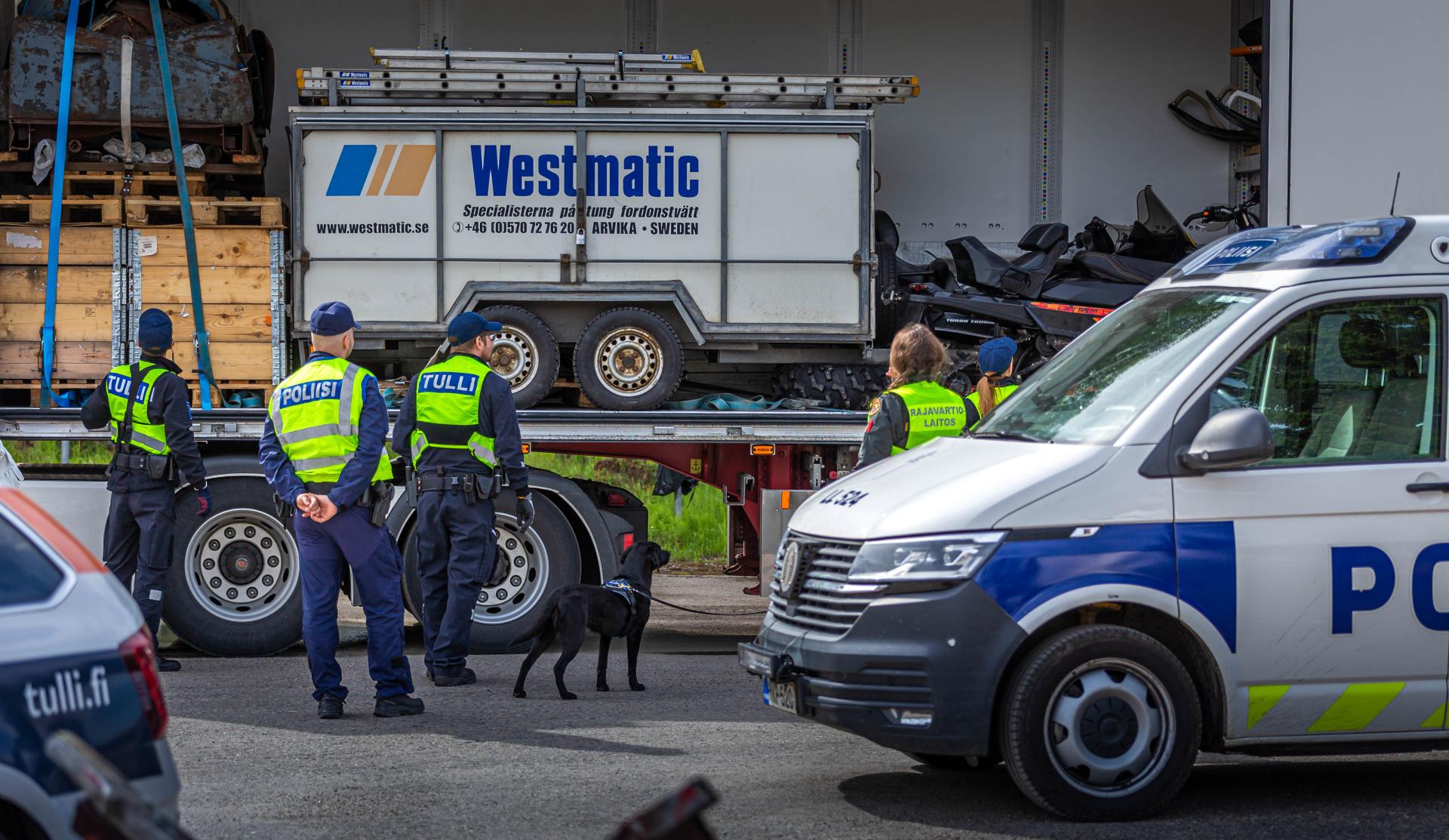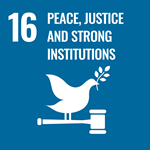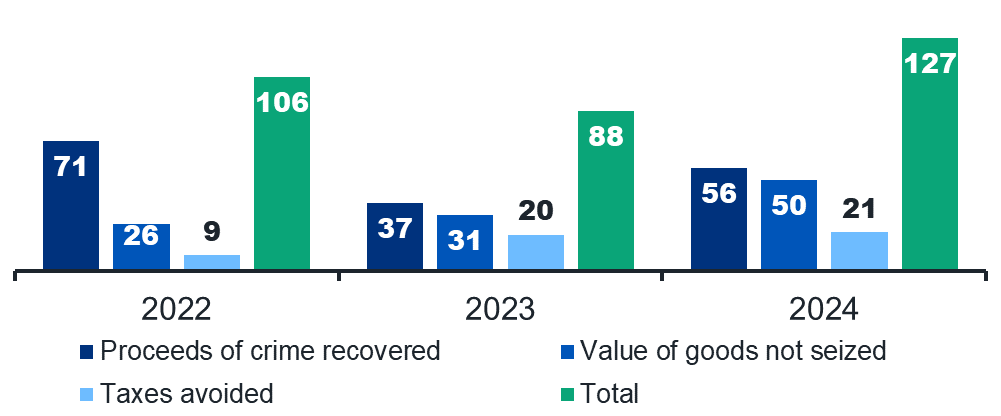We target our controls and crime prevention in response to continuous changes in our operating environment. As a security authority, Finnish Customs has an increasing responsibility for the security of society and all of its citizens. We supervise goods and passenger traffic at the external and internal borders of the EU and the Schengen Area on behalf of ministries and other agencies. By stopping restricted or prohibited substances from entering the country, we prevent the adverse social and economic effects they would cause. In addition, we promote health, environmental protection and the realisation of human rights. Ensuring undisrupted foreign trade supports fiscal security and helps maintain the national security of supply.
We fight cross-border crime by working closely with other law enforcement agencies. Our work makes crime less lucrative, limiting the potential for organised criminals to operate successfully while promoting fair competition among lawful business operators.
Sanctions enforcement ensures that the European Union’s joint foreign and security policies are effective in national and international cooperation and in promoting peace. This has required extensive expertise from us in risk-based identification, the classification of goods and intervention in cases of non-conformance.
We monitor the import and trade of counterfeit products. This allows us to protect consumers, safeguard the State’s tax revenue and the financial interests of rights-holders and combat forced and child labour, money laundering and other criminal financing.
Our sustainability efforts
Russia’s invasion of Ukraine and the resulting sanctions against Russia kept Finnish Customs very busy in 2024.
Russia invaded Ukraine on 24 February 2022. The EU quickly began tightening sanctions against Russia. Since then, the sanctions have been extended and tightened several times. A total of nine packages of sanctions were imposed in 2022, three in 2023, and three in 2024, of which the latest, or the 15th package, came into effect on 17 December 2024.
Enforcement of sanctions
EU sanctions against Russia have wide-ranging impacts on various sectors of the economy and society. The sanctions affect the movement of goods, the export of services and know-how, banking, financial and insurance operations, transport, the movement of persons and EU funds, among other things. Finnish Customs is tasked with supervising the movement of goods and, in some respects, traffic and the movement of persons.
However, most of Finnish Customs' enforcement of sanctions against Russia has consisted of monitoring import and export sanctions on goods, which is Finnish Customs' core duty. Every EU sanctions package has contained sanctions on goods, with new goods added continuously. Iron and steel products, coal and other solid fossil fuels, crude oil and petroleum products, gold and goods that generate large amounts of revenue for Russia (such as timber and car tyres) are subject to import bans. Export embargoes apply to defence materiel, firearms and firearm supplies, dual-use goods, oil exploration, production and refining technology, high technology, aerospace goods, banknotes in the official currencies of EU Member States, maritime goods and technology, luxury goods (such as electronics and household appliances) and goods contributing to Russia’s industrial capabilities (such as paints, varnishes and lubricants).
Export control is now an even more important part of the effective enforcement of the European Union's sanctions against Russia. In this context, export control refers broadly to the control of exports of all strategic goods. Strategic goods include all defence equipment and so-called dual-use goods, which, as their name suggests, are suitable for both civilian and military use or the development of weapons of mass destruction, for example. Through effective export control, Customs ensures that the European Union's common foreign and security policy measures are effective and that the objectives set for them are fully achieved. The monitoring of sanctions has kept a large number of Customs personnel busy and created work in functions across organisational boundaries.
Sanctions are circumvented by increasingly complex means
Finnish Customs has been kept busy with the European Union's sanctions against Russia and the related investigations. Since the start of the war in Ukraine, Finnish Customs has detected almost 30,000 anomalies in goods traffic, of which 3,700 have undergone targeted checks. Finnish Customs has opened preliminary investigations into sanctions violations in a total of 900 cases.
Since the eastern border was closed, the number of minor regulation offences has fallen significantly. Compared to the time before the sanctions, the amount of freight traffic between Finland and Russia at the eastern border stations had already decreased by about 90%. In addition, the border crossing points at the eastern border were closed throughout 2024. Only the Vainikkala railway crossing point remained open for goods traffic.
However, the numbers of ordinary and aggravated regulation offences have remained high. In 2024, Finnish Customs recorded nearly 100 regulation offences related to sanctions violations, 35 of which were investigated as aggravated offences. The courts have convicted several dozen offenders.
Information on sanctions available to customers
Customs aims to provide its customers with advance guidance that is as timely and high in quality as possible. A separate page on Customs' website was published on the sanctions against Russia. Customs maintains and updates the page in Finnish, Swedish, English and Russian. In addition, Customs advises customers on matters related to sanctions in Finnish, Swedish, and English. Comprehensive guidelines have also been drawn up for travellers. They provide answers to frequently asked questions from customers in Finnish, Swedish, English and Russian.
Read more
The EU's new sanctions against Belarus aim to prevent sanctions circumvention
Finnish Customs Enforcement 2024: Finnish Customs uncovered an aggravated regulation offence – attempted transportation of electronics purchased from foreign online stores to Russia via intermediate storage
The number of narcotics offences that Finnish Customs was made aware of increased significantly compared to the preceding years. In 2024, Customs uncovered a total of 5,527 offences, of which 2,055 were narcotics offences. The number of major drug crime cases increased, and there were more aggravated narcotics offences than ever before (562). Seizures of marijuana, cocaine and amphetamines in particular surpassed the threshold for aggravated offences. There were also more ordinary narcotics offences than in previous years. Most of them are uncovered in postal traffic.
Finnish Customs' most significant drug crime investigations show that the serious and organised drug crime in Finland has become increasingly professional and international. Drug smuggling and trafficking are carried out by multinational criminal networks that use trusted individuals and service providers around the world. The perpetrators and the proceeds of the crimes are concealed using measures to enhance anonymity, such as highly encrypted communication channels and cryptocurrencies. More violence is used in international activities.
Drug seizures increased dramatically
In 2024, Finnish Customs seized a total of 2,052 kg of drugs, almost double the amount seized in the previous year. Seizures of marijuana, amphetamines and cocaine in particular skyrocketed. The amount of marijuana seized in 2024 was by far the largest in history at 1,321 kg. The amount of cocaine seized was more than three times as much as in the previous year at 53 kg. Finnish Customs seized 237 kg of amphetamines, many times the amount seized in previous years.
Finnish Customs seized a total of 57 kg of hashish. LSD was seized in much larger quantities than in the previous year: 4,300 doses were seized. In contrast, substantially less ecstasy was seized than in previous years: only 16,970 pills. Similarly, Finnish Customs seized 350 kg of khat, less than in the previous year. Heroin seizures have been small in recent years. Finnish Customs seized only 20 g of heroin in 2024.
Record quantities of narcotic medications seized
A record number of narcotic medications were seized in 2024, totalling nearly 648,900 pcs, compared to just over 430,000 in 2023. A single investigation accounted for the lion’s share, when 450,000 tablets were discovered.
Read more
Finnish Customs Enforcement 2024: Crime situation
Finnish Customs Enforcement 2024: Quantities of smuggled cocaine continue to climb
Finnish Customs Enforcement 2024: Around 20 million euros worth of marijuana seized
Customs systematically develops its ability to identify various goods that pose a threat. Threats to citizens and situations that endanger everyday safety must be prevented very comprehensively. For this reason, Finnish Customs has enhanced its expertise with regard to CBRNE threats.
CBRNE refers to the threats arising from the misuse of or accidents involving chemical (C), biological (B), radiological (R), nuclear (N) and explosive (E) materials.
Identifying substances that pose a threat is one of Finnish Customs’ core tasks
Controlling various chemical substances is Finnish Customs’ core task. The substances include, for example, drugs, doping agents, psychoactive substances prohibited from the consumer market, or industrial chemicals in cross-border goods transport. From Finnish Customs’ perspective, all of this is about controlling chemicals that could cause intentional or unintentional threats to society.
Every year, plenty of goods and substances are sent to the Customs Laboratory for analysis after arriving in Finland or at Finland’s border with inadequate markings or no markings whatsoever. Such substances include, for example, compounds that are toxic to humans, animals or plants and dual-use chemicals that could be used to manufacture explosives or narcotics.
Proper labelling, storage and transportation of hazardous materials can prevent unintentional CBRNE threats.
Therefore, the correct and timely identification of substances and goods that pose a threat is a prerequisite for preventing both situations that threaten the safety of citizens and other CBRNE accidents.
Monitoring equipment and training lay the foundation for preventing threats
Customs personnel maintain their CBRNE expertise by participating in training organised by other authorities and the Customs Laboratory, among other things. The capabilities of Finnish Customs are also maintained by procuring and updating measuring devices to respond to emerging CBRNE threats, both in the field and at the Customs Laboratory. For example, Finnish Customs has enhanced its expertise in identifying certain pathogens and biological drugs that pose threats. New technology has been procured for this purpose with funding from the EU’s Customs Control Equipment Instrument (CCEI).

Active cooperation between authorities on CBRNE
Finnish Customs’ personnel regularly attend cooperation exercises conducted by national and international authorities. In accordance with the Ministry of Defence’s National CBRNE Strategy 2024, Finnish Customs is responsible for protecting society by, for example, combating the import, export and transit of hazardous items and substances. Finnish Customs does this work actively by means such as authorisation controls and samples examined by the Customs Laboratory.
Read more
International funding granted to Finnish Customs
Finnish Customs Enforcement 2024: Finnish Customs monitors and identifies CBRNE substances that pose threats
Finnish Customs’ dog operations support the operational work of Finnish Customs’ enforcement personnel. Dog activities aim to prepare for any changes and threats in our security environment. Customs dogs and their handlers work in daily passenger and goods traffic flows to support and participate in customs controls and crime fighting. Customs dogs help prevent non-compliant traffic without causing unreasonable inconvenience or delays to compliant traffic. Customs dogs and various technical tools complement each other. In this work to protect society, Finnish Customs’ official dogs and their handlers have proven to be effective, productive and economical work partnerships as part of the enforcement personnel.
Customs dogs identify different substances from drugs to food
The first customs dogs were trained to find drugs in Finland as early as 1969, and the majority of customs dogs are still trained to find drugs. Over the years, a few customs dogs have also been trained to search for cigarettes, cash, weapons, explosives, and food. In addition, during the coronavirus pandemic, the sensitivity and accuracy of customs dogs were studied as official work in the action to prevent a generally hazardous communicable disease and track the virus.
Dogs conducted approximately 30,000 checks
In 2024, a total of 45 customs dogs worked for Finnish Customs. Customs dogs are assigned to locations based on the focus areas of customs controls and geographical coverage. The numbers, training programmes and placement also take into account the fact that dogs can be moved smoothly in changing passenger and cargo flows and in the event of an investigation into customs crimes.
Quantitative and qualitative targets have been set for Finnish Customs’ dog activities. In the past year, approximately 30,000 inspections were carried out by customs dogs and their handlers. Customs dogs were involved in uncovering goods subject to import and export restrictions or prohibitions with a total value of more than €20 million. A significant share of the products were drugs.
Read more
Finnish Customs Enforcement 2024: Finnish Customs’ sniffer dogs work hard for our safety
The police, Finnish Customs, the Finnish Border Guard, and the Finnish Security and Intelligence Service are security authorities responsible for Finland's security in accordance with their respective duties and powers. Close cooperation between the security authorities is essential at all times, but its importance is highlighted in the increasingly complex world.
The aim of the PCB partnership between the police, Customs, the Border Guard and the Security and Intelligence Service is to promote security in a flexible, rapid and effective manner. The statutory duties of the PCB authorities have been arranged to overlap partially. If necessary, these authorities may carry out tasks for which a different authority is principally responsible in a separately agreed manner.
Finnish Customs in border control tasks
The offices on the eastern border remained closed throughout 2024. The border closure radically altered the operating environments of both Finnish Customs and the Finnish Border Guard. The situation required the Finnish Border Guard to reassign personnel on the eastern border, both to prevent illegal entries and conduct enhanced border controls. Conversely, Finnish Customs’ offices on the eastern border had very little to do.
Due to the reassignment of personnel, the Border Guard requested administrative assistance from Customs, which was approved. Finnish Customs personnel who were already prepared for border control tasks under the Nuija agreement were assigned to border control sites in northern Finland.
As the executive assistance proved successful and sensible for both parties, it has continued, and more Finnish Customs personnel have been trained. The present goal is to provide all the supervision personnel on the eastern border with the readiness and capability to take on border control tasks.
Executive assistance to the police
In response to a request for administrative assistance from the police, Finnish Customs assigned some of its personnel to the Joutseno reception centre. Finnish Customs is tasked with supporting the police, the Finnish Border Guard and the Finnish Immigration Service in managing general affairs and helping the other authorities to focus more on registration tasks. In case a coordination centre is established, Finnish Customs personnel are also trained in registration tasks.
New strategy for PCB activities
The changed operating environment and security situation create challenges for the activities of the authorities and also require the development of the PCB partnership. Preparing for these challenges has involved updating the PCB strategy and the guidelines and goals of the partnership to match the current operating environment and its requirements. The new strategy for 2025–2028 was approved by the PCB management team on 25 November 2024, and it came into effect on 1 January 2025.
The police, Customs, the Border Guard and the Security and Intelligence Service have a long tradition of cooperation. The close, flexible and efficient cooperation between the PCB authorities is internationally recognised. The work carried out in recent years aims to develop opportunities for cooperation further while ensuring the safety of society.
Read more
Finnish Customs Enforcement 2024: Finnish Customs supporting other enforcement authorities—PCB cooperation at its best
The changed operational environment emphasizes the role of Finnish Customs as a security authority – Minister of Finance Riikka Purra visited the closed eastern border
Since 2016, the customs authorities of EU Member States have been cooperating to strengthen and harmonise external border control at the land borders of the Union.
CELBET (Customs Eastern and South-Eastern Land Border Expert Team) is a joint project involving 11 countries that has succeeded in harmonising inspection processes, improving border crossing infrastructure and creating effective cooperation structures and tools. Cooperation and networking have strengthened and improved operational cooperation and enabled high-quality customs control at the EU's external borders.
Finland has played an important role in developing an assessment tool for measuring the efficiency of infrastructure and operations at border crossing points, among other things. The tool has been used at border crossing points at the EU's external borders with the aim of harmonising and streamlining operations. Work will continue in the spring of 2025 with regard to road traffic at border crossing points.
In addition, representatives of Finnish Customs have been involved in developing practices for customs inspection measures. Based on the guidelines drawn up, joint measures have been taken in cooperation with other CELBET countries to strengthen external border control. The guidelines have also been used in the training of border personnel.
Joint action by EU Member States to safeguard the Union's economic and security interests and enhance cooperation related to different modes of transport will continue in a new form when the new expert group EUCAB (EU Customs Alliance for Borders) starts operating in spring 2025.
Read more
Tullin vuosi 2024 (in Finnish, link to be published later)
Indicators
Effectiveness of crime prevention (EUR million)
Crimes that Finnish Customs became aware of
Crime resolution rate
The crime resolution rate measures the ratio between reported crimes and solved crimes during a specific reporting period. The decrease in the resolution rate compared to the previous year reflects the fact that in 2024, the number of preliminary investigations into suspected customs offences that were initiated was approximately 21% higher than the number of crimes solved and preliminary investigations concluded during the same period. This means that criminal investigations have piled up.



